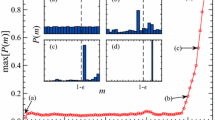Abstract
The purpose of this article is to analyse the conditions of emergence and the properties of irreversibility on a network linked to agents microbehaviors when facing technological choices. The focus is on the formation of irreversibilities related to the emergence of a single standard when considering competition among alternative technologies. Two broad classes of models are analysed. On one side, those models that exhibit irreversibilities related to the properties of sequence of choices within a finite population (percolation, Markov random fields, Gibbs random fields...). On the other side, models where the formation of irreversibilities is driven by the continuous growth of a population (Polya urn schema, Arthur’s models...).
Résumé
ľobjectif de cet article est ďanalyser les conditions ďémergence et les propriétés liées à la formation ďirréversibilité sur un réseau ďagents économiques devant choisir entre différentes technologies. Ľirréversibilité étudiée est liée à la formation ďun standard unique à partir de technologies en compétition. Ľarticle distingue deux grandes classes de modèles. D’ une part les modèles oú ľirréversibilité est liée à une séquence de choix à travers une population finie (modèles de percolation, de champ de Markov aléatoire, de champ de Gibbs aléatoire...). D’autre part, des modèles où ľirréversibilité est étudiée à travers une population croissante ďadopteurs sur le réseau (modèle ďurne de Polya, modèles ďArthur...).
Similar content being viewed by others
References
Allen (D.). Network externalities and critical mass.Telecommunications Policy (1988).
Arrow (K.),Fischer (A.). Environmental preservation, uncertainty, and irreversibility.Quarterly Journal of Economics (mai 1974).
Arthur (W. B.). Competing technologies: an overview. In G. Dosi and alii (eds),Technical change and Economic Theory, Pinter (1988a).
Arthur (W. B.). Self-reinforcing mechanisms in economics. In P. W. Anderson and alii,The Economy as an Evolving Complex System, Addison Wesley (1988b).
Arthur (W. B.). Competing technologies, increasing returns, and lock-in by historical events.The Economic Journal (1989),99.
Arthur (W. B.),Ermoliev (Yu.),Kaniovski (Yu.). On generalized urn schemes of the polya kind.Cybernetics (1983),19.
Arthur (W. B.),Ermoliev (Yu.),Kaniovski (Yu.). Strong laws for a class of path-dependent urn processes.In Proceedings of the International Conference on Stochastic Optimisation, Springer lecture notes control and information sciences (1986),81.
Arthur (W. B.),Lane (D. A). Information contagion.Structural Change and Economic Dynamics (1993),4.
Blume (L.). The statistical mechanics of social interaction.Mimeo Cornell (1991).
Callon (M.). Variété et irréversibilité dans les réseaux de conception et ďadoption des techniques.Ecole des Mines (1991).
Cohendet (P.). Apprentissage organisationnel et cohérence: ľimportance économique de la notion de réseau.Colloque de Cerisy (juin 1993).
Cohendet (J. A.),Héraud (J. A.),Zuscovitch (E.). Apprentissage technologique, réseaux économiques, et appropriabilité des innovations.In Technologie et la richesse des nations, Document Foray et C. Freeman, Edition Economique (1992).
Cowan (R.). Tortoises and hares: choice among technologies of unknown merit.The Economic Journal (1991),101.
Dalle (J. M.). Décisions autonomes et coexistence des technologies.Mimeo IEPE (1994).
David (P.). Technical choice, innovation and the economic growth.Cambridge University Press (1975).
David (P.). Clio and the economics of qwerty.American Economic Review (1985),75.
David (P.). Dépendance du chemin et prévisibilité des systèmes dynamiques avec externalités de réseau localisées: un paradigme pour ľéconomie historique.In D. Foray and C. Freeman, Technologie et richesse des nations, Economica (1992).
David (P.),Foray (D.). Percolation structures, Markov random fields and the economics of EDI standards diffusion.Discussion paper series, n° 326,CEPR, Stanford University (1993).
Farrell (J.),Saloner (G.). Standardization, compatibility and innovation.Rand Journal of Economics (1985),16.
Foray (D.). Choix des techniques, rendements croissants et processus historiques.In La technoscience, J. Prades, EditionsĽ Harmattan (1992).
Foray (D.). Les modèles de compétition technologique: une revue de la littérature.Revue Economique (1989),48.
Hammersley (J. M.),Broadbent (S. R.). Works on percolation quoted by D. Stauffer. Introduction to percolated theory.Taylor and Francis (1985).
Hammond (P.). Changing tastes and coherent dynamic choice.Review of Economic Studies (1976).
Hammond (P.). Consequentialism and the independance axiom.In Risk, Decision and Rationality, B. Munier, Editions Reidel Publications (1988).
Henry (C). Investment decisions under uncertainty: the irreversibility effect.American Economic Review (dec. 1974).
Katz (M.),Shapiro (C). Network externalities, competition and compatibility.American Economic Review (1985),75.
Katz (M.),Shapiro (C.). Technology adoption in the presence of network externalities.J Political Economics (1986),94.
Kinderman (R.),Snell (L.). Markov random fields and their applications.Contemporary Mathematics, American Mathematical Society (1980),1.
Kirman (A.). Economies with interacting agents.European University Institute, Florence (1993).
Orlean (A.). Contagion des opinions et fonctionnement des marchés financiers.Revue Economique (1992).
Ruillère (J. L.). De Fexternalité de réseau à ľ apprentissage en réseau.Université Lyon Lumière (1994).
Schelling (T.). Micromotives and macrobehavior.Norton (1978).
Strotz (R.). Myopia and inconsistency in dynamic utility maximisation.Review of Economic-Studies (1956).
Tirole (J.). The theory of industrial organization.MIT Press (1988).
Turpin (E.). Ľenfance des réseaux: Zénon, le boulanger et les réseaux.Communications et Stratégie IDATE (2e trimestre 1992).
Umbhauer (G.). Information incomplète et qualité des produits.Thèse de Sciences Economiques, Université Louis Pasteur, Strasbourg1 (1989).
Willinger (M.). Irréversibilité et cohérence dynamique des choix.Revue ďEconomie Politique (nov.-déc. 1990).
Author information
Authors and Affiliations
Additional information
Ce travail a bénéficié ďun soutien de France Télécom (cnet et dps).
Rights and permissions
About this article
Cite this article
Cohendet, P. Networks, diffusion of technologies and irreversibilities. Ann. Télécommun. 50, 234–245 (1995). https://doi.org/10.1007/BF02999996
Received:
Issue Date:
DOI: https://doi.org/10.1007/BF02999996
Key words
- Economic analysis
- Microeconomics
- Competition
- Percolation
- Random field
- Economic model
- Dynamic model
- Externality
- Economic agent network




